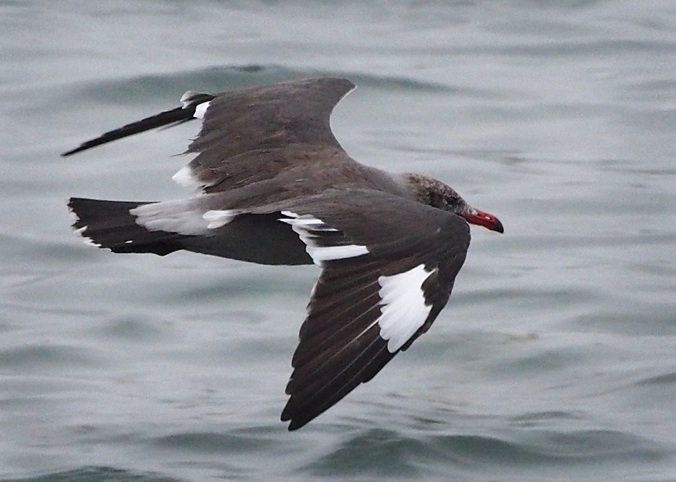A practical guide to bird watching in Sonoma County, California
(Unless otherwise indicated, all phone numbers are in the 707 area code)
A practical guide to bird watching in Sonoma County, California
(Unless otherwise indicated, all phone numbers are in the 707 area code)


A distinctive and fairly common gull in the county, but only in the summer and autumn months. Heermann's Gull generally arrives around mid-July, although some birds may be here as early as a month before that. Most are gone by early December. Greatest numbers are present in August, September, and October. Usually not present in February, March, April, and May. Sticks mainly to the coast. Known as a parasite, harassing pelicans and other birds to steal food. Unlike most gulls, which generally breed north of us and then winter in our area, Hermann's Gull breeds south of us, in Mexico, on islands in the Sea of Cortez (or the Gulf of California, mostly on Isla Rasa), flying north to our area after breeding. Attains adult plumage in the third year.
Probably the easiest gull to identify among those we commonly see in Sonoma County. Heermann's Gull is the only gull we see that has a red bill (the tip is dark). The legs are black in all plumages, but may become darker in breeding plumage. The eye is always dark but sports a bright red orbital ring in breeding season (see photo below) and the gape shows bright red as well. Otherwise, mostly a medium grey but with a dark grey mantle, which may become darker in breeding plumage. In the non-breeding plumage we mostly see in the county, the head will be mottled with grey as in the photo above (clean white in breeding plumage), the bill will be a bit paler and more orange and have a less clearly defined black tip than when in full breeding plumage. Juvenile birds are a fairly uniform chocolate brown with a dark bill pink at the base (photo below).
Aberrant plumage: A small number of Heermann’s Gulls show an interesting variation with much white in the wings where normal birds have none (photo below). According to Sibley, about one in 200 Heermann’s Gulls shows white upper primary coverts, creating a substantial white patch in the wings. The bird in the photograph below has additional white also in the secondaries and elsewhere in the wing. Sibley points out that these birds are particularly likely to be mistaken for South Polar Skua (Stercorarius maccormicki).
Also see: A comparison of common gull heads in breeding and non-breeding plumages
Further reading:
Bolander and Parmeter, Birds of Sonoma County California, rev. ed., 2000, p. 61
Brinkley, National Wildlife Federation Field Guide to Birds of North America, 2007, p. 132
Dunn and Alderfer, eds., National Geographic Field Guide to the Birds of North America, 5th ed., 2006, pg. 198
Dunn and Alderfer, eds., National Geographic Field Guide to the Birds of North America, 6th ed., 2011, pg. 218
Dunne, Pete Dunne’s Essential Field Guide Companion, 2006, pp. 259-260
Howell and Dunn, Gulls of the Americas, 2007, pp. 22, 94, 100, 102-106, 356, 357-359
Ehrlich, Dobkin, and Wheye, The Birder's Handbook, paperback edition, 1988, pg. 160
Fix and Bezener, Birds of Northern California, 2000, p. 172
Floyd, Smithsonian Field Guide to the Birds of North America, 2008, p. 192
Kaufman, Field Guide to Birds of North America, 2000, p. 86
Kaufman, Advanced Birding, 1990, pp. 89, 100-101
Kaufman, Field Guide to Advanced Birding, 2011, pp. 242, 262, 302, 315
Lukas, Bay Area Birds: From Sonoma County to Monterey Bay, 2012, pp. 56, 121-122, 136
Parmeter and Wight, Birds of Sonoma County California, Update (2000-2010), 2012, p. 34
Peterson, Field Guide to Birds of Western North America, 4th ed., 2010, p. 174
Peterson, Western Birds, 3rd ed., 1990, p. 90
Sibley, Field Guide to Birds of Western North America,1st ed., 2003, p. 198
Stokes, Stokes Field Guide to the Birds of North America, 1st ed., 2010, p. 308-309
Vuilleumier, American Museum of Natural History, Birds of North America: Western Region, 2011, p. 164
Voice: Cornell Lab of Ornithology: All About Birds--Heermann's Gull
© Colin Talcroft, 2009, 2010, 2011, 2012, 2013
Unless noted, all photos by the author. If you would like to use one of my images, please ask for permission for non-commercial use with proper credit or commercial use with proper compensation.
Heermann's Gull (non-breeding plumage), Carmel (Monterey County), December 30, 2011
Heermann's Gull, breeding and non-breeding plumages. Carmel (Monterey County), December 30, 2011
Note clear white head, deep red bill with clearly defined black tip, very dark mantle, and black legs of the middle bird
in full breeding plumage. Top bird is in breeding plumage but still showing hints of dark among the head feathers.
Bottom bird is in non-breeding plumage--note mottled head, paler, more orange bill;
more diffuse, dark bill tip; paler legs and mantle


Heermann's Gull, breeding plumage
Monterey (Monterey County), December 30, 2011
Note clear white head, scarlet bill, scarlet orbital ring,
clearly defined black bill tip


Immature Heermann's Gull, Monterey (Monterey County), December 30, 2011
Heermann's Gull
Larus heermanni
1990-2013 Sonoma County data. Graph provided by eBird (www.ebird.org), generated July 10, 2013
EBird reported occurrence in Sonoma County



Aberrant Heermann's Gull, near Campbell Cove, Bodega Bay, September 20, 2013
According to Sibley, Heermann’s Gulls with white upper primary coverts occur in about 1/200 adult birds. This variation seems rarer than that to me. This bird has additional white in the secondaries, where it normally is not present even in aberrant birds.